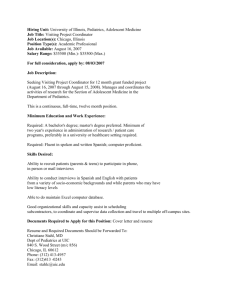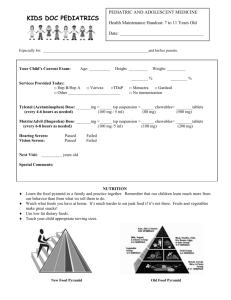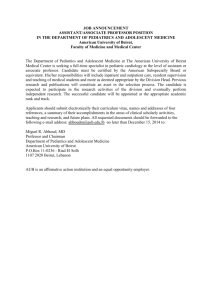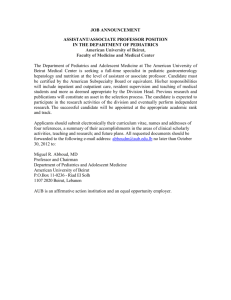EPC Exhibit 130-19
advertisement
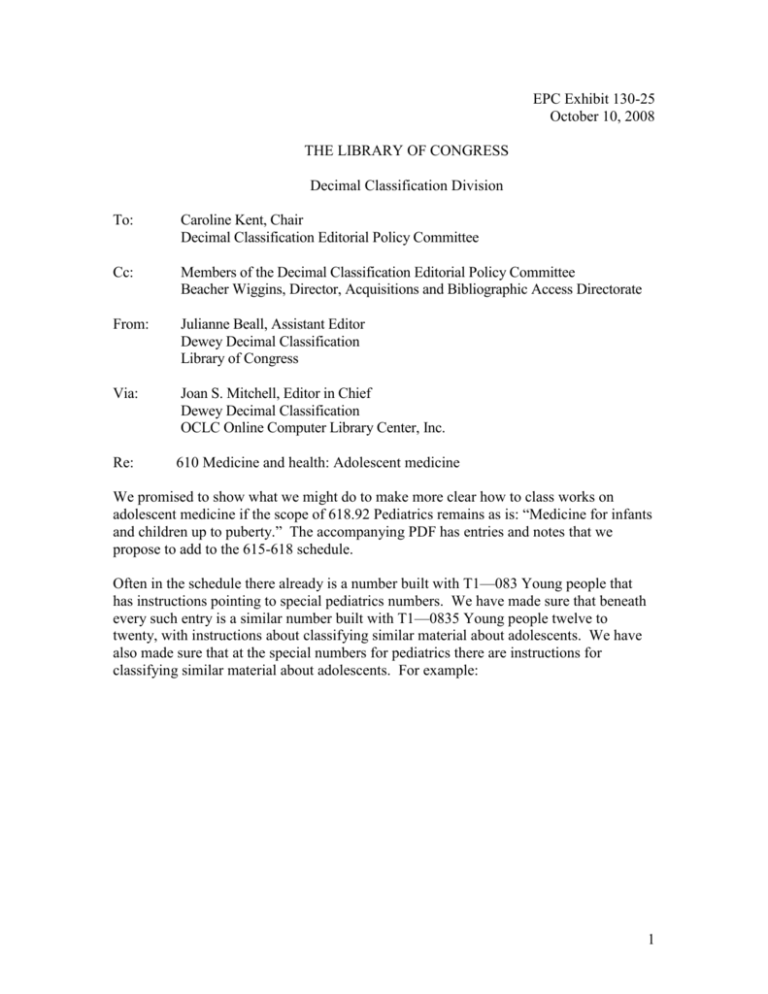
EPC Exhibit 130-25 October 10, 2008 THE LIBRARY OF CONGRESS Decimal Classification Division To: Caroline Kent, Chair Decimal Classification Editorial Policy Committee Cc: Members of the Decimal Classification Editorial Policy Committee Beacher Wiggins, Director, Acquisitions and Bibliographic Access Directorate From: Julianne Beall, Assistant Editor Dewey Decimal Classification Library of Congress Via: Joan S. Mitchell, Editor in Chief Dewey Decimal Classification OCLC Online Computer Library Center, Inc. Re: 610 Medicine and health: Adolescent medicine We promised to show what we might do to make more clear how to class works on adolescent medicine if the scope of 618.92 Pediatrics remains as is: “Medicine for infants and children up to puberty.” The accompanying PDF has entries and notes that we propose to add to the 615-618 schedule. Often in the schedule there already is a number built with T1—083 Young people that has instructions pointing to special pediatrics numbers. We have made sure that beneath every such entry is a similar number built with T1—0835 Young people twelve to twenty, with instructions about classifying similar material about adolescents. We have also made sure that at the special numbers for pediatrics there are instructions for classifying similar material about adolescents. For example: 1 615.508 3 Young people Do not use for therapeutics for infants and children up to puberty, comprehensive works on child and adolescent therapeutics; class in 615.542 615.508 35 Young people twelve to twenty Do not use for therapeutics for young people twelve to twenty who have not reached puberty; class in 615.542 Class here therapeutics for adolescents 615.542 Pediatric therapeutics Class here comprehensive works on child and adolescent therapeutics Class adolescent therapeutics in 615.50835 For a specific aspect of pediatric therapeutics, see the aspect, plus notation 083 from Table 1, e.g., exercise therapy for children 615.82083 In the long add tables at 616.1–616.9, 617, and 618.1–618.8, the new and modified entries and notes can all be found at 0083 or 00835. The following entries are included for context: 615.5 Therapeutics; 616 Diseases; 617.5 Regional medicine; 617.6 Dentistry; 618 Gynecology, obstetrics, pediatrics, geriatrics; and 618.2 Obstetrics. The Relative Index portion of the PDF has index entries for all the records shown in the schedule part of the PDF, plus many built-number index-only entries for diseases with LCSH of the form “[Disease] in adolescence.” We have also added some adolescent medicine Relative Index entries to correspond to pediatrics entries, particularly entries of the form Pediatric [specialty] and [Specialty]—pediatrics, e.g., Adolescent cardiology and Cardiology—adolescent medicine to match Pediatric cardiology and Cardiology— pediatrics. We could add many more such entries. Below in three appendixes are the pediatrics and adolescent medicine portions of (1) minutes of the discussion of EPC Exhibit 129-25; (2) EPC Exhibit 129-25; and (3) EPC Exhibit 128-29. 2 Appendix 1 From page 36 of EPC 130-3.pdf Minutes of Meeting 129 25. 610 Medicine and health (Exhibit 129-25) Joan Mitchell: This exhibit includes selective updates to medicine, plus an update on the treatment of adolescent medicine. ..... Julianne Beall: . . . . With pediatrics there is the question of how to handle adolescent medicine. There is no consistency around the world on the dividing line. There isn’t a good place to put adolescent medicine. Lyn McKinney: No matter what you do, will you leave a definition up to the individual country? Julianne Beall: We want to make it clear where it goes. Andrea Kappler: I found with my daughter that there is no cut off. Lyn McKinney: My daughter’s pediatrician said the cut off is eighteen. Winton Matthews: There is no consensus to move; therefore it makes more sense to leave it where it is, plus add built numbers to make clear where adolescent topics go. Joan Mitchell: Perhaps we could add more built numbers as an interim solution. One problem is libraries that cut off Dewey numbers. Exhibit 129-25 was accepted, except for adolescent medicine, on the motion of Deborah Rose-Lefmann, seconded by David Farris. 3 Appendix 2 From EPC Exhibit 129-25 Pediatrics and adolescent medicine only 618.92 Pediatrics EPC Exhibit 128-29 had a discussion-only section about changing the scope of pediatrics to include adolescent medicine and about establishing a specific number under 618.92 for comprehensive works on adolescent medicine. The section pointed out that if comprehensive works on adolescent medicine are moved from 616.00835 to pediatrics, the obvious number for comprehensive works (618.92000835) would have three zeros. Comments about the pediatrics question in EPC Exhibit 128-29 were mixed. 128-29 610 Medicine and health CILIP recommends an adolescent medicine number within pediatrics—the committee prefers the triple-zero ss approach. Dr. Heidrun Alex, Deutsche Nationalbibliothek, wrote: 618.92 Pediatrics (discussion only) (pages 33-35) In German we understand a juvenile person of 18 to 21 years as adolescent. So we would prefer 616.00835. Our source is Meyer’s dictionary. As youth lasts from the age of 12 to 20 we would place works about childhood and adolescence in 618.92. We consider a possible notation 618.92000835 as not advisable. EPC asked us to place the question on the Dewey blog. We have done so at <http://ddc.typepad.com/025431/2008/03/does-pediatrics.html>. To date we have received three responses to the blog: The NHS rules in Italy are as follows: the maximum age to be cared by a pediatrician is 14, the minimum to be cared by a general practitioner is 7. According to the Italian Federation of Pediatricians (http://www.fimp.org/menusx/chisiamo.aspx), they care all children up to 6 and most from 7 to 14. Posted by: Ottavio Rizzo | March 26, 2008 at 09:21 AM ____________________________________ In Sweden, pediatrics seems to include adolescent medicine. Medicine services for children in general accept persons with a maximum age of 4 16 or 18, and definitions in reference sources includes adolescents medicine in the scope of pediatrics. Posted by: Magdalena Svanberg | April 01, 2008 at 08:46 AM _____________________________________ Good morning, We are a medium sized county public library system which uses Dewey numbers no longer than 3 places past the decimal. We are considering the possibility of extending our Dewey numbers to 4 places past the decimal in a few selected areas, 618.928 being one of these. Moving adolescent medicine to pediatrics would not be desirable from our point of view. Already we have a mixed bag of subjects in 618.928 and adding adolescents to it would only increase the size of our mixed bag. While these comments aren't theoretical in nature, the practicality from our point of view is important to us. Thank you. Joycelyn F. Brand Technical Services Librarian Dakota County Library 1340 Wescott Road Eagan, MN 55123 651-450-2965 Joycelyn.Brand@co.dakota.mn.us Note: One of the examples in the blog concerns 618.928526. We are looking for advice from EPC on how to proceed on this matter. The pediatrics section of EPC Exhibit 128-29 and the text of the blog are both given in an appendix to this exhibit. 5 Appendix 3 From EPC Exhibit 128-29: 618.92 Pediatrics (discussion only) The scope of 618.92 Pediatrics in the DDC is defined by the first three notes: 618.92 Pediatrics: Medicine for infants and children up to puberty Class here comprehensive works on child and adolescent medicine For medicine for young people who have reached puberty, see 616.00835 The problem with that scope is that it conflicts with many other current definitions of the scope of pediatrics. Many other current definitions of pediatrics include young people past puberty. (Some medical dictionaries just mention children in the definition of pediatrics, but it is not always clear what they mean by children. Stedman’s Medical Dictionary [27th ed.] is clear: "The medical specialty concerned with the study and treatment of children in health and disease during development from birth through adolescence.") The LCSH Pediatrics has no scope note, and its 550 RT headings are limited to children; but the LCC number in the 053 is RJ. The LCC RJ Pediatrics has the scope note: "Class here works on infants through two years; children through 15 years; adolescents through 21 years." Near the end of the RJ schedule is RJ550 Diseases of adolescence. The LCSH Adolescent medicine has RJ550 in the 053 field. There is a reference out of RJ for adolescent pregnancy. The scope note for the MeSH Pediatrics is "A medical specialty concerned with maintaining health and providing medical care to children from birth to adolescence." Does that mean up to but not including adolescence? Perhaps. There is also a MeSH heading "Adolescent Medicine" with the scope note: "A branch of medicine pertaining to the diagnosis and treatment of diseases occurring during the period beginning with puberty until the cessation of somatic growth." The next steps up in the MeSH hierarchy for Pediatrics are "Specialties, Medical" then "Medicine." The next step up in the MeSH hierarchy for "Adolescent Medicine" is "Medicine." The NLM class WS Pediatrics does not have a scope note defining the age range, but adolescents are clearly included, e.g.: WS 200-342 Diseases of Children and Adolescents WS 405-460 By Age Groups. . . . WS 460 Adolescence (General) WS 462-463 Adolescent Psychology. Adolescent Psychiatry Here is a quotation from the American Academy of Pediatrics: 6 Welcome to the official Web site of the American Academy of Pediatrics—an organization of 60,000 pediatricians committed to the attainment of optimal physical, mental, and social health and well-being for all infants, children, adolescents, and young adults. http://www.aap.org/about.html We are hoping for feedback from other countries: does the scope of pediatrics in most countries include adolescents, or not? The issue of the scope of pediatrics is no problem in DDC for the many comprehensive works on child and adolescent medicine, at least not in the sense of causing classifier errors. The fact that so many works on pediatrics include adolescent medicine, however, does lead to adolescent medicine being split up when works on adolescent medicine alone are correctly classed elsewhere. There is a potential problem that end users may expect to find all works on adolescent medicine with pediatrics, though I have had no complaints relayed to me. There are few classification errors with comprehensive works on adolescent medicine; the see reference at 618.92 seems to work well for them. There are 44 hits in WorldCat for dd: 616.00835, e.g., Adolescent Medicine (http://www.worldcatlibraries.org/oclc/124505653) and Adolescent Medicine: A Handbook for Primary Care (http://www.worldcatlibraries.org/oclc/58043221). There are more problems with classification errors for works on specific kinds of disorders limited to adolescents; apparently classifiers do not always read up the hierarchy to find the see reference. For example, Adolescent Eating Disorders (http://www.worldcatlibraries.org/oclc/58790986) is misclassed in 618.928526. Eating Disorders in Children and Adolescents (http://www.worldcatlibraries.org/oclc/71347506) is correctly classed in 618.928526. Eating Disorders in Adolescence: Anorexia and Bulimia Nervosa (http://www.worldcatlibraries.org/oclc/32705493) is correctly classed in 616.852600835. The number of errors does not seem overwhelming. I was expecting more errors than I found. Here are relevant WorldCat hits: dd: 616.852600835 31 hits dd: 618.928526 74 hits su= "eating disorders in adolescence" 390 hits dd: 618.928526 and (su= "eating disorders in adolescence") 40 hits Probably most of the 40 works in the last category are correctly classed. Should we retain the current scope of 618.92 Pediatrics and try to find additional ways to minimize the errors? Or should we bow to current concepts of the scope of pediatrics and try to avoid splitting adolescent medicine by moving it all into pediatrics? If we move to pediatrics, the 7 obvious number for comprehensive works on adolescent medicine, 618.92000835, will have three zeros. Another possibility, 618.9203, falls between infants—specifically sudden infant death—at 618.92026 and chronic diseases at 616.9204; that is not very attractive. Will it be necessary to have a separate comprehensive number for adolescent medicine, other than 618.92000835? One might be tempted to specify that comprehensive works on adolescent medicine be classed simply in 618.92 Pediatrics; but that is not desirable because adolescent medicine is a distinctive field, with the major medical publishers having textbooks on the subject. From 025.431: The Dewey blog, March 25, 2008: Does pediatrics include adolescent medicine? The Decimal Classification Editorial Policy Committee (EPC) and the Dewey editorial team seek advice. The scope of 618.92 Pediatrics is defined by the first three notes in the entry: Medicine for infants and children up to puberty Class here comprehensive works on child and adolescent medicine For medicine for young people who have reached puberty, see 616.00835 The problem is that many other definitions of the scope of pediatrics include young people past puberty. For example: Welcome to the official public Web site of the American Academy of Pediatrics - an organization of 60,000 pediatricians committed to the attainment of optimal physical, mental, and social health and well-being for all infants, children, adolescents, and young adults. The Indian Academy of Pediatrics in India makes a similar statement (stopping with adolescents, not including young adults). Is the broader definition of pediatrics that includes adolescents widespread in the world? We have received indications that it is, but we would like to hear from more countries. If we broaden the scope of 618.92 Pediatrics, there will be no change in the treatment of comprehensive works on child and adolescent medicine in general; they are already in 618.92. There will also be no change in the treatment of comprehensive works on child and adolescent medicine of a specific disease; those works are already classed in subdivisions of 618.92. What will change is the placement of adolescent medicine in general; it will be moved from 616.00835 Adolescent medicine (built with 616 Diseases plus an extra zero as shown at 616.001-616.009 Standard subdivisions plus T1—0835 Young people twelve to twenty) to a subdivision of 618.92 Pediatrics. 8 What will also change is the placement of adolescent medicine with respect to a specific disease. For example, If Your Adolescent Has an Eating Disorder: An Essential Resource for Parents is currently classed in 616.852600835 Eating disorders in adolescents (built with 616.8526 Eating disorders plus an extra zero as indicated in the add table under 616.1-616.9 Specific diseases plus T1—0835 Young people twelve to twenty). Meanwhile, Eating Disorders in Childhood and Adolescence is classed in 618.928526 Eating disorders in children and adolescents (built with 618.92 Pediatrics plus 8526 from 616.8526 Eating disorders, following instructions at 618.921-618.929 Specific diseases). If we broaden the scope of 618.92 Pediatrics, works treating only adolescents will also be classed in 618.928526, plus an extra zero and T1—0835 Young people twelve to twenty. Is the broader definition of pediatrics that includes adolescents widespread in the world? Should we broaden the scope of 618.92 Pediatrics to match? Please reply directly to this blog entry. If you prefer, you may also send comments and suggestions directly to dewey@loc.gov. Posted by Juli at 07:35 PM in 600-699 Technology | Permalink 9
